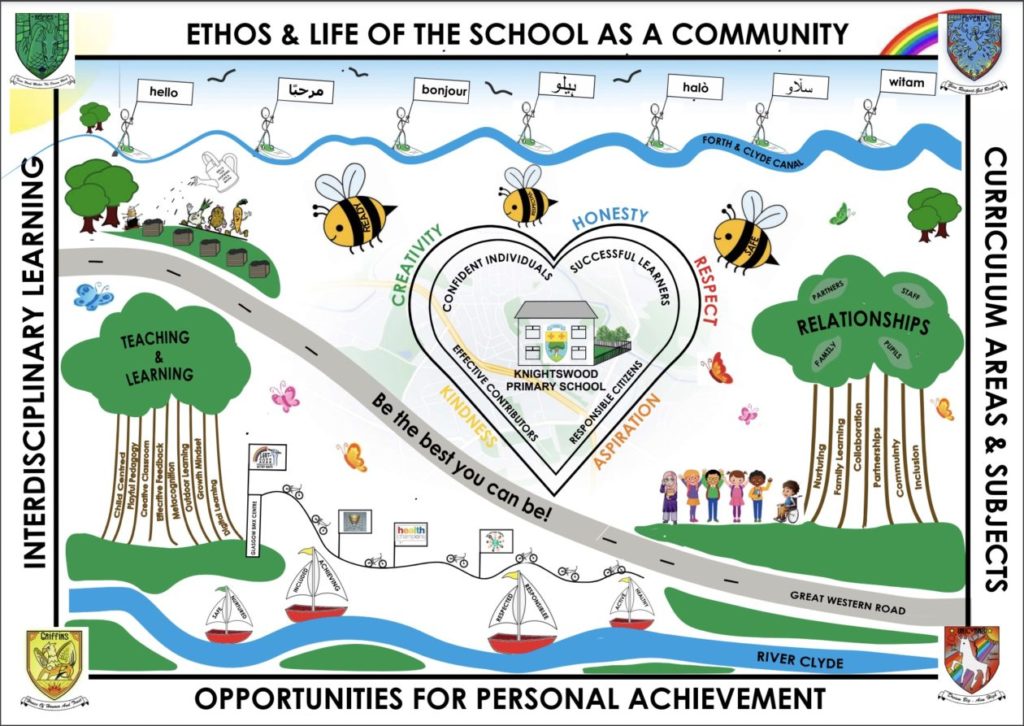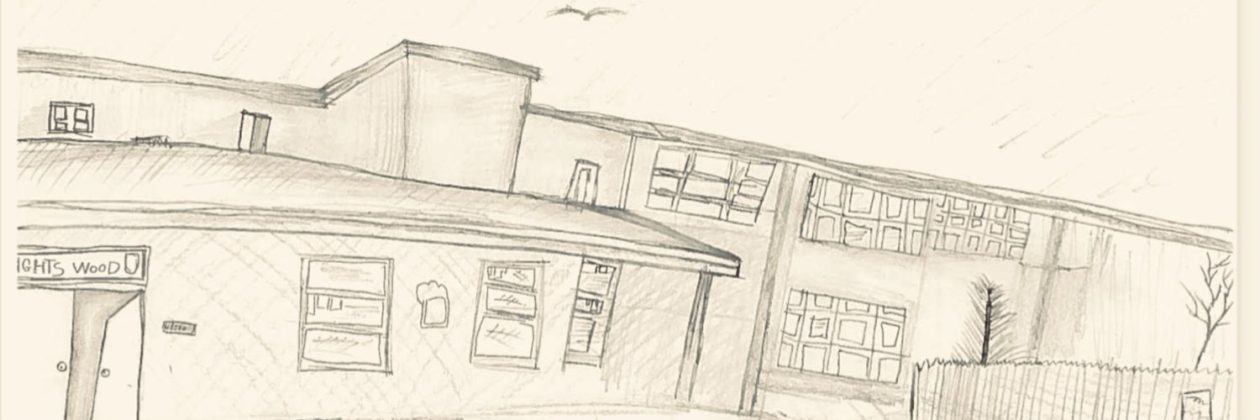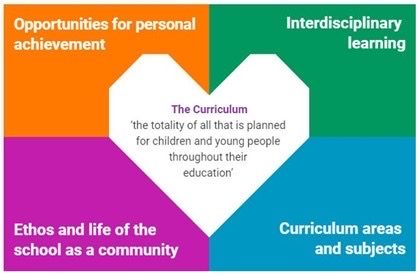KPS Curriculum Rationale

One of the biggest areas we wanted to
refresh was our vision, values and aims.
We wanted our curriculum to reflect on our new values, our clear vision and our aims of:
☑️ Providing opportunities for every child to develop skills for lifelong learning (Article 28)
☑️ Create a nurturing environment which embraces and celebrates diversity (Articles 3,8)
☑️ Foster effective partnerships with pupils, parents and the wider community to ensure a sustainable future (Articles 12, 29)
From the outset the staff were very clear that the rationale for the curriculum should be based on the school’s shared vision:
Provide a safe, inclusive, happy, nurturing and stimulating environment where learners celebrate diversity and achieve their potential.
Using that as a starting point, the school community came together to design a rationale. The process centred around dialogue focused on what everyone wanted to achieve for the learners in the school and what was involved in providing a high-quality education for all learners.
It was essential that everyone understood the purpose and principles of Curriculum for Excellence. All staff were involved in the self-evaluation process, evaluating the current curriculum and identifying best practice.
We also sought the views from our learners, parents and the wider school community on what they felt the key features were that brought the curriculum ‘alive’.
From the wide range of information gathered during the consultation period the curriculum rationale aims were created:
☑️ We need a curriculum which focuses on the Knightswood child as a learner, and allows breadth and depth of learning, offering challenge and enjoyment, personalisation and choice
☑️ With progression through levels being closely monitored and tracked to ensure the opportunity of attainment
Our rationale and its design promotes the 7 principles and supports learners’ development of skills and knowledge across all areas, takes account of the school’s local circumstances and of local and national advice.
It is both a flexible framework and working document which leaves scope for teams and individual teachers to introduce well-considered innovations to meet the needs of all learners and for the school to keep it under review to ensure it is fit for purpose.
The rationale has ensured that the whole school community has a shared understanding of what we are trying to achieve.
As the school moves forward it recognises the importance of taking quality time to evaluate and review curriculum innovation and learn from our evolving best practice.
Impact:
When a school has a rationale for its curriculum, it means that everyone involved with the school can answer the questions:
‘What is it we want for our learners?’
and ‘What are we going to do to achieve it?’
We focused on staff awareness, understanding, staff confidence, and the key curriculum drivers.
It is important to ensure that everyone within the school is clear about what they are aiming to achieve through the curriculum, which is the totality of a child’s experiences.
Staff are now aware that an effective curriculum provides teachers, learners, school leaders and community stakeholders with a measurable structure for delivering a quality education.
Thinking of the curriculum as both a window and a mirror might also guide our decision-making (Style, 1988).
It is about celebrating KPS’ heritage and history, our diversity, what our community brings to school… but also being very clear that we have got powerful knowledge and information that we want our children to learn
Impact on curriculum priorities and planning:
We now aim to create:-
☑️ ambitious, capable learners, ready to learn throughout their lives
☑️ enterprising, creative contributors, ready to play a full part in life and work
☑️ ethical, informed citizens of Scotland and the world
☑️ healthy, confident individuals, ready to lead fulfilling lives as valued members of society
So what have you taken forward as a result on this professional learning? (What has changed?)
☑️ Core areas are now embedded within the wider curricular competencies and include communication, creative and critical thinking, positive personal and cultural identity, personal awareness and responsibility, and social responsibility.
☑️ We now encourage our curriculum to embrace depth not breadth, and provide multiple opportunities for interdisciplinary connections.
☑️ Ensure connections to local and global communities are an important aspect of our curriculum and its design.
Impact on Curriculum Design and Making:
☑️ Our teachers work towards creating the conditions necessary for curriculum to be enacted effectively in a variety of different learning environments.
☑️ Teachers are encouraged to attend to the social aspects of learning while creating environments that encourage learners to take risks and express different viewpoints/perspectives.
☑️ Teachers are more confident about making professional judgments about curriculum design in order to be responsive to learners’ needs, interests, background, curiosities, and passions.
☑️ Teachers ensure that learning experiences are meaningful and relevant.
☑️ Teachers craft learning intentions incorporating learner voice, choice and flexibility.
We now have a sharper focus on IDL and on DYW, linking to rich local learning experiences and partnership working.
As we are all aware, IDL has the potential to stimulate the curiosity and motivation of learners, and enhance the development of all four capacities of CfE: successful learners; confident individuals; effective contributors; responsible citizens.
We now have an increasing and sharper focus on IDL. With staff continuing to develop their understanding of IDL. Staff are now starting with the experiences and outcomes, carefully selecting the three curriculum areas. We are now developing that connections between disciplines within the IDL are clear and meaningful and that learning does not get lost within the context.
In all lessons, as part with our Tapestry developments, the purpose and benefits of IDL are more carefully considered.
Our planning now reflects children applying existing knowledge and understanding. Our assessment of IDL is planned as an integral part of the learning and teaching, based around the success criteria.
Next steps are to ensure a whole-school framework of IDL is developed to ensure progression and coherence.
We are continuing to promote the importance of developing the workforce skills where children can discuss connections between life experiences and use and develop higher order thinking skills.
So what makes a good curriculum rationale?
1. It both creates and reflects culture and identity
2. It keeps up with the changing world
3. It helps supports making learning and teaching consistent
4. It opens the doors for collaboration for partnership working
Curriculum for Excellence Scotland
Further information can be found by clicking the picture above.
What is the Curriculum for Excellence
Bringing learning to life and life to learning.
Curriculum for Excellence is Scotland’s curriculum for children and young people aged 3-18. It is an approach designed to provide pupils with the knowledge, skills and attributes they need for learning, life and work in the 21st century. It aims to enable every child to be a:
- successful learner
- confident individual
- responsible citizen
- effective contributor
It aims to raise standards, prepare our children for a future they do not yet know and equip them for jobs of tomorrow in a fast changing world.
Curriculum for Excellence enables professionals to teach subjects creatively, to work together across the school and with other schools, to share best practice and explore learning together.
Teachers and practitioners will share information to plan a child’s “learning journey” from 3-18, helping their progression form nursery to primary, primary to secondary and beyond, ensuring the challenge is smooth. They’ll ensure children continue to work at a pace they can cope with and with challenge they can thrive on.
Curriculum for Excellence balances the importance of knowledge and skills.
Every child is entitled to a broad and deep general education, whatever their level and ability. Every single teacher and practitioner will be responsible for literacy and numeracy – the language and numbers skills that unlock other subjects and are vital to everyday life.
It develops skills for learning, life and work to help young people go on to further study, secure work and navigate life. It brings real life into the classroom, making learning relevant and helps young people apply lessons to their life beyond the classroom. It links knowledge in one subject area to another helping children understand the world and make connections. It develops skills so that children can think for themselves, make sound judgements, challenge, enquire and find solutions.
There will be new ways of assessing progress and ensuring children achieve their potential. There will be new qualifications for literacy and numeracy and from 2013/14 new National 4 and 5 qualifications will be in place. Our well regarded Access, Highers and Advanced Highers will be updated to take account of and support the new approaches to learning and teaching.
There’s personal support to help young people fulfil their potential and make the most of their opportunities with additional support wherever that’s needed. There will be a new emphasis by all staff on looking after our children’s health and wellbeing – to ensure that the school is a place where children feel safe and secure.
Ultimately, Curriculum for Excellence aims to improve our children’s life chances, to nurture successful learners, confident individuals, effective contributors, and responsible citizens, building on Scotland’s reputation for great education.


